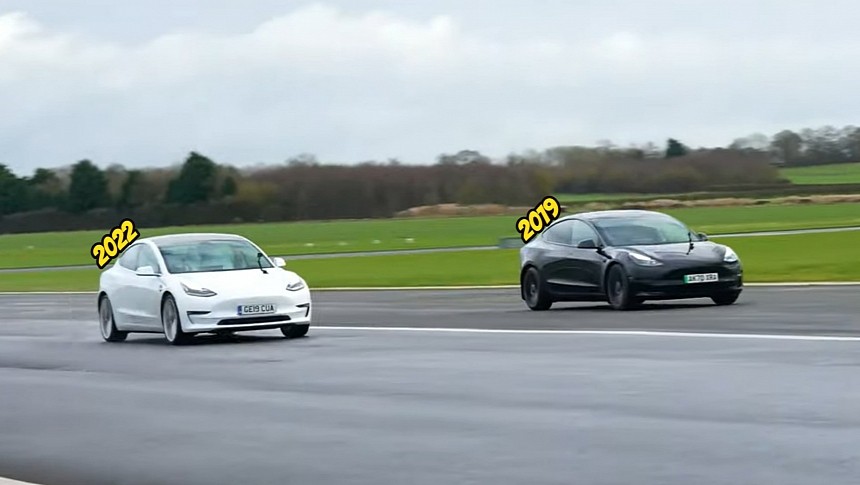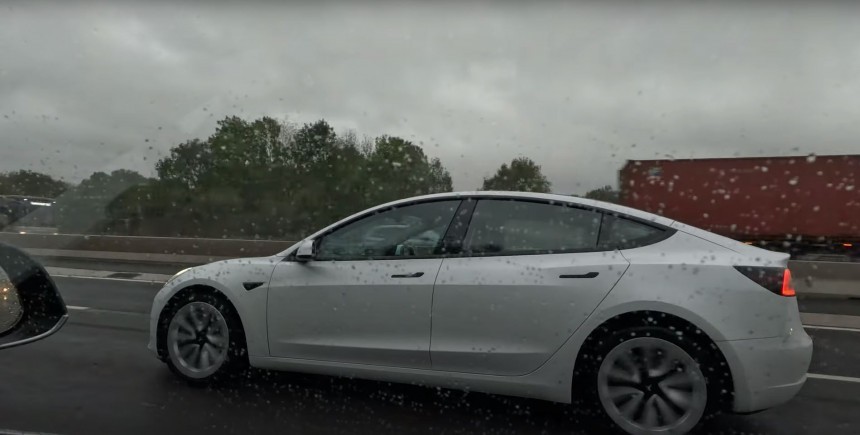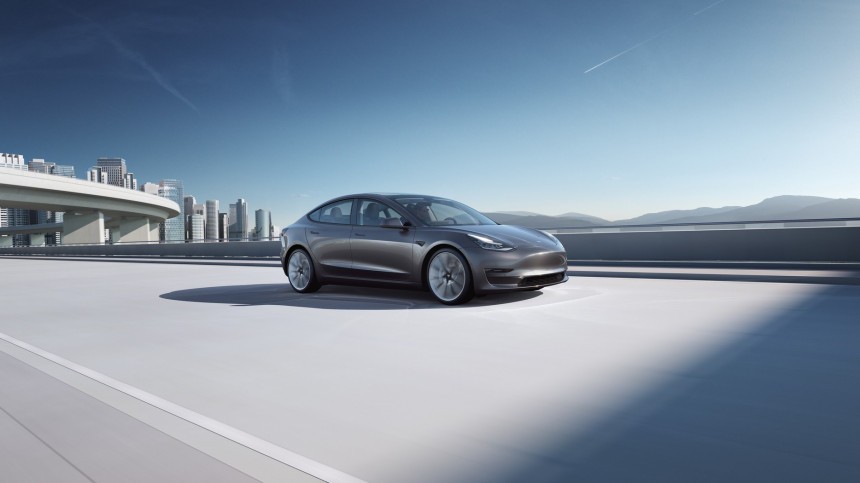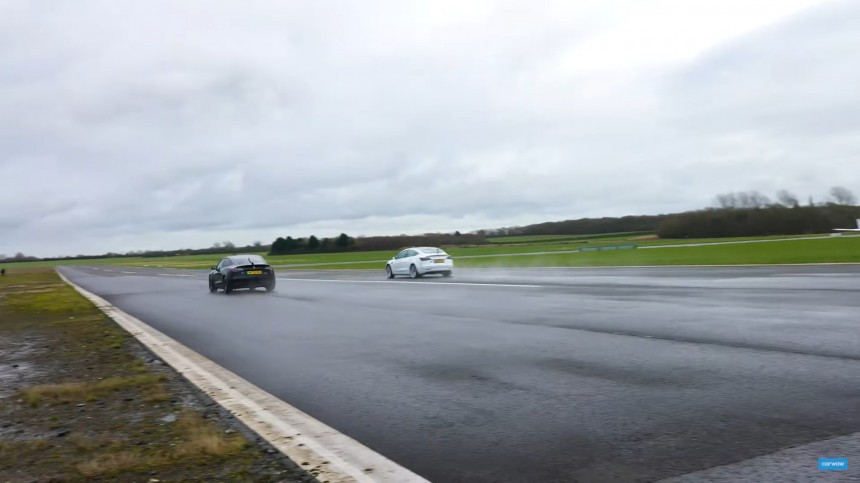The main differences between the two all-wheel-drive EVs are the heat pump and a slight increase in battery size. The 2022 model-year Tesla has both these advantages, while the 2019 Model 3 must make do with what the automaker gave it. But which one is a better buy? Here's an independent real-world test showing how far you can go on a single charge. It also puts the two siblings through a charging session that resembles what most of us would typically do.
The Environmental Protection Agency (EPA) tells us that the 2019 Model 3 Long Range can go 310 miles on a full battery with an efficiency of 29 kWh per 100 miles or 3.44 miles per kWh.
On the other hand, the 2022 Model 3 Long Range gets 358 miles of range and consumes 26 kWh per 100 miles or goes 3.8 miles per kWh.
We can instantly figure out that the newer EV is much better when it comes to squeezing every electron possible for more range.
But we must not forget that the EPA does its testing in a lab where it charges the car to 100% and puts it through its paces until the energy storage unit is depleted. That's not something that most people do because range anxiety comes into play. Moreover, charging to 100% is rarely recommended, as is driving until the battery hits a 0% state of charge.
So, a real-world range test is the better way to understand which car is the smarter choice.
The 2019 model-year unit had around 37,000 miles on the odometer and rode on 19-inch wheels. It started the road trip with a 72% state of charge.
Before preconditioning the 75-kWh battery to Supercharge faster, the EV displayed an efficiency of 3.8 miles per kWh, which can also be interpreted as 26.3 kWh per 100 miles.
Preconditioning ate 4.4% of the battery's charge level and dropped the efficiency by 0.2 miles per kWh.
It arrived with a little over 14.6% left in "the tank."
The 2022 model-year Tesla, equipped with similar 19-inch wheels, started the journey with an 81% state of charge.
Before activating preconditioning, the EV had an efficiency of 4.1 miles per kWh or 24.3 kWh per 100 miles. It remained unchanged because getting the 79-kWh battery warmer for faster Supercharging needed just 0.7% of the energy storage unit's available electricity.
It arrived with just a smidge over 40% state of charge.
Keep in mind that both cars had the A/C on during this drive.
Both started charging at a rate of 148 kW at V3 stalls, but it quickly grew to 255 kW after one of the Tesla Model 3s was disconnected. It proved that the charger was at fault and not the car.
Theoretically, V3 dispensers shouldn't share power, but in this case, almost all were occupied. That might have affected their capacity to dispense energy at the highest rate possible.
After moving to a different stall, the pair noticed that the older EV charged a bit faster than the 2022 Model 3. Tesla switched to lithium iron phosphate (LFP) batteries in 2022. The 2019 model-year unit's energy storage unit had the lithium nickel cobalt aluminum (NCA) chemistry.
The guys also included in their comparison a 2021 Model 3 Long Range with a 75-kWh battery that rode on 18-inch wheels. That unit had the best efficiency of 4.6 mi per kWh or 21.7 kWh per 100 miles, but it wasn't too relevant because the outside and traffic conditions changed.
Thus, the main differentiating factor and the only one that truly matters is the price. Currently, a brand-new non-Highland Model 3 Long Range will set you back at least $45,990 without the EV tax credit.
A dual-motor 2022 Model 3 Long Range costs between $26,000 and $37,000.
A dual-motor 2019 Model 3 Long Range costs between $22,000 and $36,000.
As things stand, buyers have two smart choices given the price ranges. Either buy a 2019 model-year unit that has a pre-tax price of $25,000 tops and take advantage of the used EV tax credit of up to $4,000, or get the 2022 model-year zero-emission car because it comes with a couple of cool and relatively useful advantages.
However, no matter what you choose to do, a Tesla Model 3 with all-wheel drive will be a great commuting appliance. Don't treat it like a sports car, and you'll most likely get to enjoy it comfortably for at least a few years.
On the other hand, the 2022 Model 3 Long Range gets 358 miles of range and consumes 26 kWh per 100 miles or goes 3.8 miles per kWh.
We can instantly figure out that the newer EV is much better when it comes to squeezing every electron possible for more range.
But we must not forget that the EPA does its testing in a lab where it charges the car to 100% and puts it through its paces until the energy storage unit is depleted. That's not something that most people do because range anxiety comes into play. Moreover, charging to 100% is rarely recommended, as is driving until the battery hits a 0% state of charge.
So, a real-world range test is the better way to understand which car is the smarter choice.
But first, the numbers
The people behind the RSymons RSEV YouTube channel took two dual-motor Model 3s and put them to a simple challenge: go from A to B (133 miles in total) on a murky day when the outside temperature fluctuated between 64 and 72 degrees Fahrenheit.The 2019 model-year unit had around 37,000 miles on the odometer and rode on 19-inch wheels. It started the road trip with a 72% state of charge.
Before preconditioning the 75-kWh battery to Supercharge faster, the EV displayed an efficiency of 3.8 miles per kWh, which can also be interpreted as 26.3 kWh per 100 miles.
Preconditioning ate 4.4% of the battery's charge level and dropped the efficiency by 0.2 miles per kWh.
It arrived with a little over 14.6% left in "the tank."
Before activating preconditioning, the EV had an efficiency of 4.1 miles per kWh or 24.3 kWh per 100 miles. It remained unchanged because getting the 79-kWh battery warmer for faster Supercharging needed just 0.7% of the energy storage unit's available electricity.
It arrived with just a smidge over 40% state of charge.
Keep in mind that both cars had the A/C on during this drive.
Both started charging at a rate of 148 kW at V3 stalls, but it quickly grew to 255 kW after one of the Tesla Model 3s was disconnected. It proved that the charger was at fault and not the car.
Theoretically, V3 dispensers shouldn't share power, but in this case, almost all were occupied. That might have affected their capacity to dispense energy at the highest rate possible.
After moving to a different stall, the pair noticed that the older EV charged a bit faster than the 2022 Model 3. Tesla switched to lithium iron phosphate (LFP) batteries in 2022. The 2019 model-year unit's energy storage unit had the lithium nickel cobalt aluminum (NCA) chemistry.
Be picky! After all, it's your money
The figures show that there's not any real difference between the two. While it's true that the newer car has better efficiency, the older one can charge a tad bit faster. If you can Supercharge, then the heat pump and the slightly larger battery might not be necessary to have on your used Model 3. That's especially true if you plug in overnight, at home.The guys also included in their comparison a 2021 Model 3 Long Range with a 75-kWh battery that rode on 18-inch wheels. That unit had the best efficiency of 4.6 mi per kWh or 21.7 kWh per 100 miles, but it wasn't too relevant because the outside and traffic conditions changed.
Thus, the main differentiating factor and the only one that truly matters is the price. Currently, a brand-new non-Highland Model 3 Long Range will set you back at least $45,990 without the EV tax credit.
A dual-motor 2022 Model 3 Long Range costs between $26,000 and $37,000.
A dual-motor 2019 Model 3 Long Range costs between $22,000 and $36,000.
As things stand, buyers have two smart choices given the price ranges. Either buy a 2019 model-year unit that has a pre-tax price of $25,000 tops and take advantage of the used EV tax credit of up to $4,000, or get the 2022 model-year zero-emission car because it comes with a couple of cool and relatively useful advantages.
However, no matter what you choose to do, a Tesla Model 3 with all-wheel drive will be a great commuting appliance. Don't treat it like a sports car, and you'll most likely get to enjoy it comfortably for at least a few years.
































